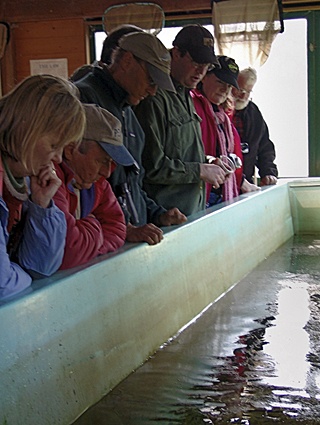Every week in the spring and summer, Andria Hagstrom and her 12-year-old son Quinn Freedman go to two different sites on Cascade Creek to monitor the water depth, the temperature and the dissolved oxygen content of the water.
They do it because it is part of a homeschooling project, because they think it’s important, and because they are Beach Watchers.
“Participating in Beach Watchers was really a tremendous opportunity for us,” Hagstrom says. “We heard about the program last winter. Marine Sciences was something we really wanted to pursue but we were unsure how to go about it.”
Along with seven other Orcas Island residents and two from Lopez, Hagstrom and Freedman attended 100 hours of university-level training with instructors who are professionals in their field. They were given a holistic picture of the eco-system and learned about the San Juan County marine and watershed environment.
“We had two months of pretty intensive training,” Hagstrom said. “There were full days of lectures and some field work.”
Each of the Beach Watchers is required to give back 100 hours in volunteering on the group’s projects, which include helping scientists with research like salmon recovery, doing outreach at state and county parks and practicing stewardship with projects like helping the land bank or tagging creosote logs for removal.
The WSU Beach Watchers Program Coordinator Shann Weston says that most of the Beach Watchers give back much more than the required 100 hours over the course of two years.
“It becomes a passion for many of them and they continue to participate,” Weston said. “They have a sincere desire to learn the material and then give back. I think this is a tremendous opportunity to learn, and enjoy learning, receiving a high quality education and then giving back to your community with service.”
Weston says she has a lifelong passion for the ocean and for working with people who feel the same, which makes her Beach Watching job the perfect match for her skills and interests.
In addition to the work at Cascade Creek, which helps provide information on native fish runs and how a range of conditions will affect the survival of Cutthroat trout, Hagstrom and Freedman have found other projects that they are interested in being involved in.
The Beach Watchers web site lists projects and each person chooses those of interest to them.
“We have done a wide variety of things,” Hagstrom said. “We did interpretive work at Lime Kilm State Park with school groups. We assisted the park ranger in helping the kids identify different animals and worked at the interpretive center. We have done research with a number of different scientists.”
One of the projects that they are excited about is setting up a community marine lab on Indian Island and Fishing Bay to study current conditions and get a sense of how urban development in Eastsound is impacting the marine environment.
“This project is open to the whole community, not just Beach Watchers,” Hagstrom said. “We would love more volunteers to work on it.”
Information for being part of the next Beach Watchers class starting April 2 is available at www.beachwatchers.wsu.edu.
“We are just approaching our 100 hours,” Hagstrom said. “Oh yes, we will continue. It is a really vital program that hooks up scientists with volunteers and makes a lot of their research possible.”




